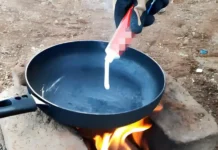Although using a screwdriver is the fastest and easiest way to unscrew something, there are other methods you can try if you can’t find a screwdriver or don’t have the right type or size. Check out these tips below!
1 Unscrewing a Phillips-head Screw
A Phillips-head screw has two grooves that form a cross on the top of the screw head. You will use the longer groove to unscrew more quickly, as there are many tools that can be adapted to fit this groove.
Phillips-head screws can easily chip when the corners formed by the two grooves become worn. So be careful when using tools other than a screwdriver to unscrew a Phillips-head screw.
 Phillips-head screw
Phillips-head screw
Method 1 Using a Butter Knife
Use a butter knife (a knife with a dull edge) and insert the knife into the longer groove, then turn it counterclockwise to unscrew.
If the knife is of poor quality or the screw is too tight, the knife may bend without being able to loosen the screw. Be careful, as there is a possibility of damaging the knife.
 Using a butter knife
Using a butter knife
Method 2 Using a Coin
Try inserting a coin into the longer groove and turning it counterclockwise to unscrew. However, this method is usually more effective for larger screws than smaller ones.
Insert the coin into the longer groove and turn it counterclockwise.
 Using a coin
Using a coin
Method 3 Using Pliers
This method only works if the head of the screw protrudes above the surrounding surface. Use pliers or locking pliers to grip the sides of the screw head and turn it counterclockwise to unscrew.
It is preferable to use needle-nose pliers as they are more effective in unscrewing than other types of pliers.
 Using pliers
Using pliers
Method 4 Using Your Thumbnail
This method only works if the screw has already been loosened.
Insert your thumbnail into the longer groove and turn it counterclockwise. If the screw is relatively loose, it will come out easily, but if it is still tight, this method will not work.
 Using your thumbnail
Using your thumbnail
Method 5 Using an Old CD
Insert the edge of a CD into the longer groove and turn it counterclockwise. You can also break and bend the CD, so you should only use old CDs that you don’t mind damaging.
If the screw is too tight, this method will not be effective.
 Using an old CD
Using an old CD
Method 6 Using a Plastic Toothbrush
Take a plastic toothbrush and melt the handle with a lighter or other heat source.
Once the plastic has softened, you can insert it into the screw head and wait for the plastic to harden. When the toothbrush handle has hardened, turn the screw counterclockwise to unscrew it.
This method is usually only effective with screws that are not too tight and are relatively easy to turn.
 Using a plastic toothbrush
Using a plastic toothbrush
Method 7 Using a Metal Saw to Create a Longer Groove on the Screw
If the head of the screw protrudes above the surface, you can use a metal saw to create a groove similar to that of a flat-head screw. Hold the saw vertically and slowly cut into the head of the screw to create a groove.
Be careful not to cut into the surrounding surface or any object that is holding the screw in place.
 Using a metal saw
Using a metal saw
2 Unscrewing a Flat-head Screw
A flat-head screw has a single groove that runs across the head of the screw. If you don’t have a flat-head screwdriver, you can use any flat surface to unscrew it.
 Flat-head screw
Flat-head screw
Method 1 Using a Card
Try using a card, such as a credit card, to turn the screw. Insert one edge of the card into the groove and turn it counterclockwise to unscrew.
Note: Use an old card that is strong enough, as the card may be damaged in the process.
 Using a card
Using a card
Method 2 Using a Can Tab
Take a can tab and insert it into the groove on the head of the flat-head screw. Turn the screw counterclockwise to unscrew it.
 Using a can tab
Using a can tab
Method 3 Using a Coin
Insert a small coin into the groove and turn it counterclockwise. A larger coin will make it easier to unscrew the screw, but it must fit into the groove.
 Using a coin
Using a coin
Method 4 Using a Butter Knife
A butter knife can be used in the same way as a coin. Insert the knife into the groove and turn it counterclockwise to unscrew the screw.
Be careful, as a weak knife may be damaged if you use too much force to unscrew the screw.
 Using a butter knife
Using a butter knife
Method 5 Using Pliers or Locking Pliers
This method only works if the head of the screw protrudes above the surrounding surface. Use pliers or locking pliers to grip the sides of the screw head and turn it counterclockwise to unscrew it.
Use needle-nose pliers for better results.
 Using pliers or locking pliers
Using pliers or locking pliers
Method 6 Using Your Thumbnail
Your thumbnail can only unscrew the screw if it has already been loosened. Insert your thumbnail into the groove and turn it counterclockwise. If the screw is relatively loose, it will come out easily, but if it is still tight, this method will not work.
 Using your thumbnail
Using your thumbnail
3 Unscrewing a Hex Socket Screw
A hex socket screw has a hexagonal indentation on the head. A hex socket screw has a pin in the center of the head that you need to be aware of when unscrewing it.
Hex socket screws are fragile, so be careful when using alternative tools to unscrew them.
 Hex socket screw
Hex socket screw
Method 1 Breaking the Pin on the Head of the Hex Socket Screw
If you have a regular hex screwdriver instead of the one designed specifically for hex socket screws, you can remove the pin in the center of the head. Use a hammer, punch, or chisel, and aim for the base of the pin. Gently tap the head of the punch to break the pin.
 Breaking the pin on the head of the hex socket screw
Breaking the pin on the head of the hex socket screw
Method 2 Drilling a Small Hole in the Head of a Hex Screwdriver
If you encounter a hex socket screw and want to unscrew it using a regular hex screwdriver or drill bit, you can drill a small hole in the drill bit. This way, you will have a small hole that fits the pin in the center of the hex socket screw.
 Drilling a small hole in the head of a hex screwdriver
Drilling a small hole in the head of a hex screwdriver
Method 3 Using a Plastic Toothbrush
Take a plastic toothbrush and melt the handle with a lighter or other heat source.
Once the plastic has softened, you can insert the toothbrush handle into the screw head and wait for the plastic to harden. When the plastic has hardened, turn the screw counterclockwise to unscrew it.
 Using a plastic toothbrush
Using a plastic toothbrush
4 Unscrewing Very Small Screws
It is very difficult to unscrew very small screws without the right tools. They are often used in electronic devices. You can use a glasses repair kit, which includes small screwdrivers, to remove these screws.


































